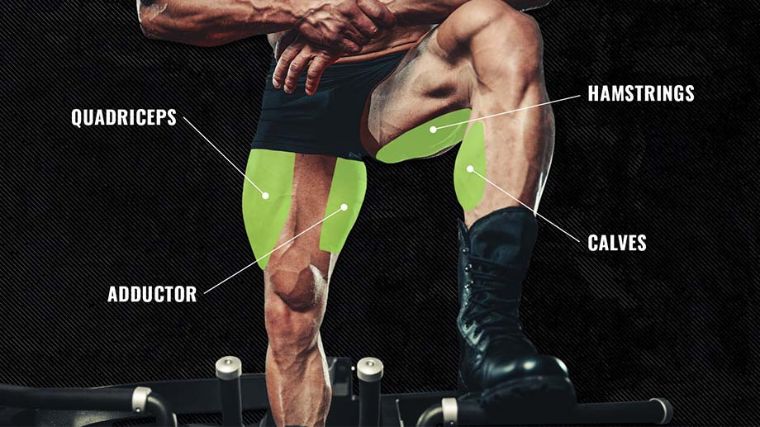20 Best Leg Exercises for Your Next Leg Day (original) (raw)
- The Exercises
- |
- Workouts
- |
- Tips
- |
- Benefits
- |
- Leg Anatomy
- |
- FAQs
You did not hear it here first, but it bears repeating: train your legs. Leg day can be a painful, DOMS-inducing experience, but ignoring your lower half also robs the body of more muscle, enhanced movement, and increased calorie burn.
Leg training is integral to your performance if you play just about any sport out there (strength-focused or otherwise). Your leg muscles produce power on the lifting platform and propel you forward on the field. To further enlighten you about the benefits and, dare we say, the fun of training your legs, we compiled a list of the best leg day exercises. Let’s get into it.
- **Back Squat
- Front Squat
- Bulgarian Split Squat
- Leg Press
- Hack Squat
- Romanian Deadlift
- Nordic Hamstring Curl
- Goblet Squat
- Reverse Lunge
- Barbell Hip Thrust
- Leg Extension
- Side Leg Raise
- Lying Leg Curl
- Standing Calf Raise
- Side Lunge
- Good Morning
- Glute Bridge
- Kettlebell Swing
- Cyclist Squat
- Belt Squat
Recent Updates: BarBend Senior Staff Writer Jake Dickson revised this list to remove some movements that didn’t align with BarBend’s contemporary standards for exercise selection. This updated list of leg exercises was vetted by multiple members of BarBend’s editorial staff and is aligned with Exercise Science best practices.
About Our Experts
This article was originally written by _BarBend_‘s former Director of Content, Andrew Gutman. It was verified by and includes recommendations from Senior Writer Dickson, who is a NASM-CPT and holds a B.S. degree in Exercise Science.
You’ll also find expert input from Kyrie Furr. Furr is a CrossFit coach, personal trainer, B.S. graduate in Sports Management, and is a former collegiate athlete.
1. Back Squat

| Equipment Needed | Squat rack, barbell, plates, lifting belt (optional), weightlifting shoes (optional) |
|---|---|
| Muscles Worked | Quads, glutes, core, lower back |
| Sets & Reps | 3 x 6 |
The back squat — often referred to as the king of lower body exercises — is a compound exercise that challenges every muscle in the legs. “Back squats are a compound exercise that engages multiple muscle groups simultaneously. They primarily target the muscles in the lower body, including the quadriceps, hamstrings, glutes, and calves,” Furr explains.
“Regularly performing back squats can help increase strength and muscle mass in these areas. This can help improve power, explosiveness, and overall athletic performance, making it beneficial for athletes in various sports.”
[Read More: The Best Squat Racks]
How To Do It
- Set a barbell in a power rack to shoulder height, loaded with an appropriate amount of weight.
- Get under the barbell, set the bar across your upper traps, or set the bar across your shoulder blades if you’re performing low-bar back squats.
- Brace your core and lift the weight out of the rack. Take small steps back one foot at a time to get yourself into position.
- With your chest up, squat down until the bottoms of your thighs are parallel to the floor. Now, drive back up by pushing your feet through the floor.
Modifications
- Make It Easier: Squat to a plyo box or weight bench to limit your depth.
- Make It Harder: Add a pause at the bottom or do one-and-a-half reps.
Coach’s Tip: Your squat stance and technique is highly individual. Take time to work out your most comfortable and sustainable posture.
2. Front Squat
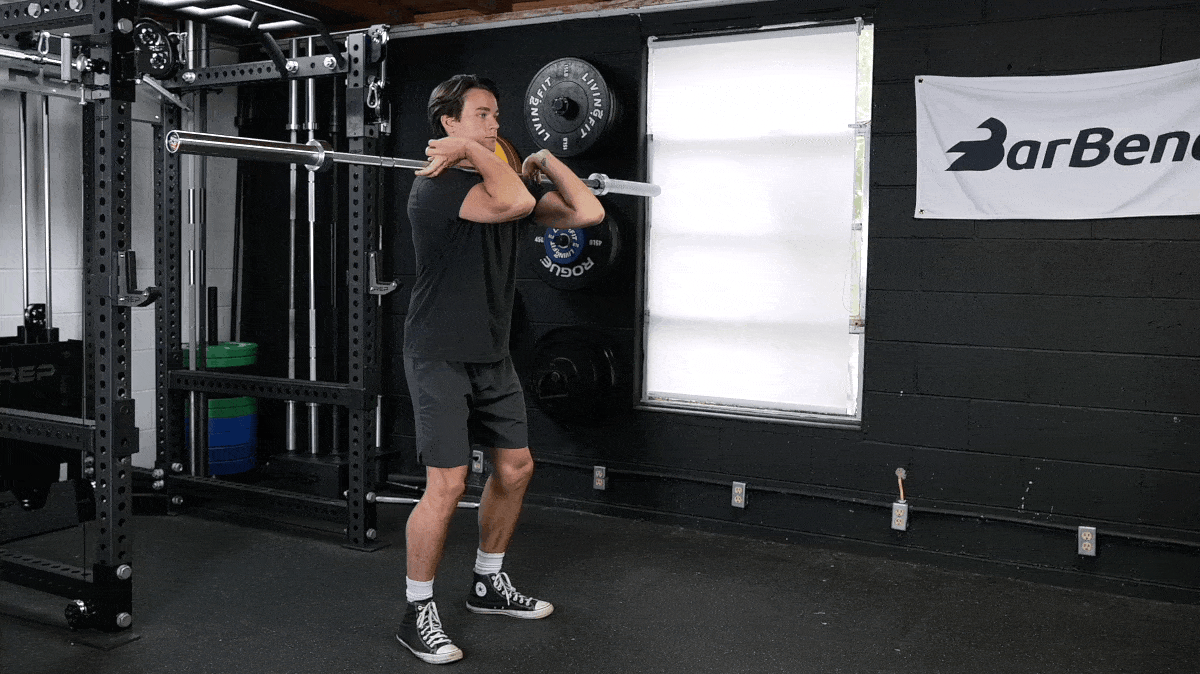
| Equipment Needed | Barbell, weight plates, squat rack, wrist wraps (optional), weightlifting shoes (optional) |
|---|---|
| Muscles Worked | Quads, core, glutes, upper back |
| Sets & Reps | 3 x 5 |
The front squat can be a tremendous substitute for the traditional back squat. If you find that the barbell back squat aggravates your lower back or you have a shoulder injury, this front squat variation may suit you instead. Because you hold the barbell in front of you, this squat variation challenges the upper back and torso muscles — shifting the load from the back to the front. This also requires more thoracic stability and forces the lifter to be upright, better for core recruitment and posture.
How To Do It
- Set a barbell in a power rack to shoulder height, loaded with an appropriate weight.
- Extend your arms directly out in front of you so that your hands are touching the bar.
- Place your middle three fingers on the bar, and then drive your palms up. Bring your elbows underneath the bar so that they’re pointing straight forward.
- Step back, so the bar is out of the rack, and keep your elbows pointing forward.
- With your chest up, squat down until the bottoms of your thighs are parallel to the floor and drive through the floor with your feet to the top.
Modifications
- Make It Easier: Grasp the bar with your fingertips instead of holding it in your palm.
- Make It Harder: Add a pause in the bottom.
Coach’s Tip: If the front rack position is uncomfortable, you may need to stretch your lats or mobilize your thoracic spine.
3. Bulgarian Split Squat
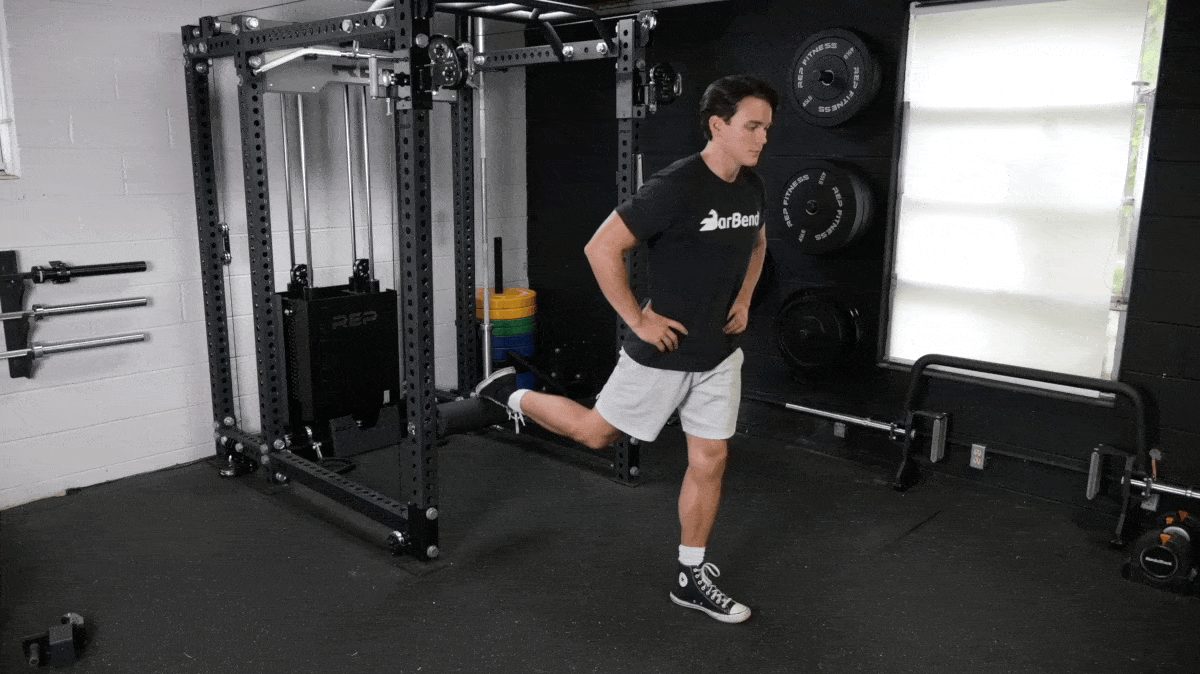
| Equipment Needed | Weight bench, dumbbells (optional), barbell (optional), weightlifting shoes (optional) |
|---|---|
| Muscles Worked | Quads, glutes, core |
| Sets & Reps | 3 x 10 |
“The Bulgarian split squat is a single leg, unilateral squat that primarily targets the quadriceps, while also working hamstrings, glutes and hips. This movement requires balance, stability and coordination which increases the need for core engagement,” explains Furr.
How To Do It
- Hold a dumbbell in each hand and stand about a foot in front of a bench. Place one foot, shoelaces down, on a bench.
- Brace your core and squat down until both of your legs bend to 90 degrees.
- You can squat down a little further, but don’t let your knee touch the floor. Hold this down position for a beat and then drive back up.
Modifications
- Make It Easier: Gently hold onto something with one arm to steady your balance.
- Make It Harder: Elevate your front foot on a weight plate to increase range of motion.
Coach’s Tip: The closer your working foot is relative to the bench, the more emphasis you’ll place on your quads via forward knee travel.
4. Leg Press
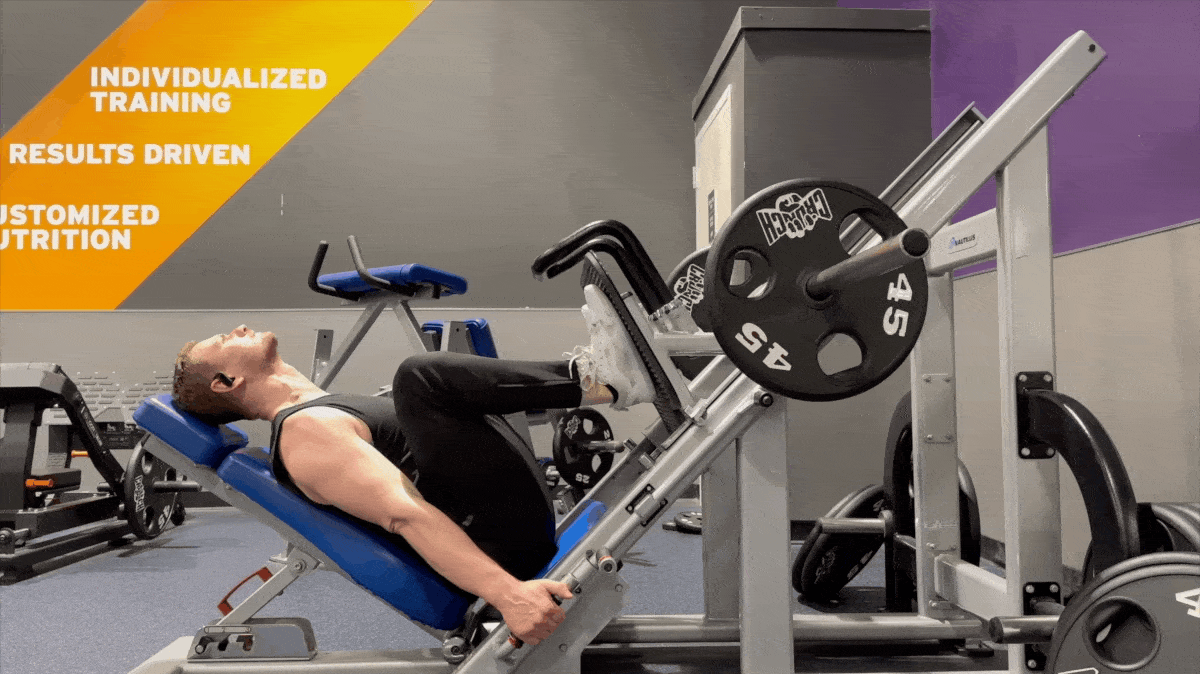
| Equipment Needed | Leg press machine, weightlifting shoes (optional), weight plates |
|---|---|
| Muscles Worked | Quads, glutes |
| Sets & Reps | 4 x 10-12 |
There is perhaps no better leg exercise for mass than the good old-fashioned leg press. This machine lets you move huge amounts of weight without loading your spine or requiring a lot of stability. It’s a great option if you want to hammer your quadriceps.
How To Do It
- Sit in the leg press seat, and place your feet in the middle of the sled, about shoulder-width apart.
- Press the sled out of the rack, lower the safety bars, and then slowly lower the sled towards your chest until your thighs break 90 degrees.
- Press the sled back up but do not lock out your knees.
- If your lower back or hips lift off the seat as you drive the weight back up, you’re going too far down.
Modifications
- Make It Easier: Tie an exercise band from the sled to the frame to give you some elastic help as you push the sled up.
- Make It Harder: Place your feet lower on the sled to challenge your ankle mobility and increase range of motion.
Coach’s Tip: Try a slightly wider foot placement to avoid having your thighs collide with your torso.
5. Hack Squat

| Equipment Needed | Hack squat machine |
|---|---|
| Muscles Worked | Quads, glutes |
| Sets & Reps | 3-4 x 8 |
The beloved brainchild of George Hackenschmidt, the hack squat is one of the best leg exercises for mass. Sharing attributes with the back squat, this exercise reinforces the squat movement pattern to increase strength which translates into countless other lifts. As a bonus, the machine creates external stability, safeguarding against injury and helping work around pre-existing injuries as it has a predefined movement pattern.
How To Do It
- Your stance on the foot platform will closely mimic that of your back squat stance. You want your feet slightly outside shoulder width with feet angled slightly outward — they should be in line with the knee as it tracks forward during the descent.
- Your torso should be stable with your abdominals engaged and your lower back flat on the back pad.
- Maintain a neutral head position as you lower your body until the bottoms of your thighs are parallel to the foot platform and drive through your feet to the top.
Modifications
- Make It Easier: Limit your range of motion, stopping when your hip crease is in line with your kneecap.
- Make It Harder: Add a pause at the bottom of each rep.
Coach’s Tip: You should be able to sink into a low squat here even if you can’t during a free-weight squat.
6. Romanian Deadlift
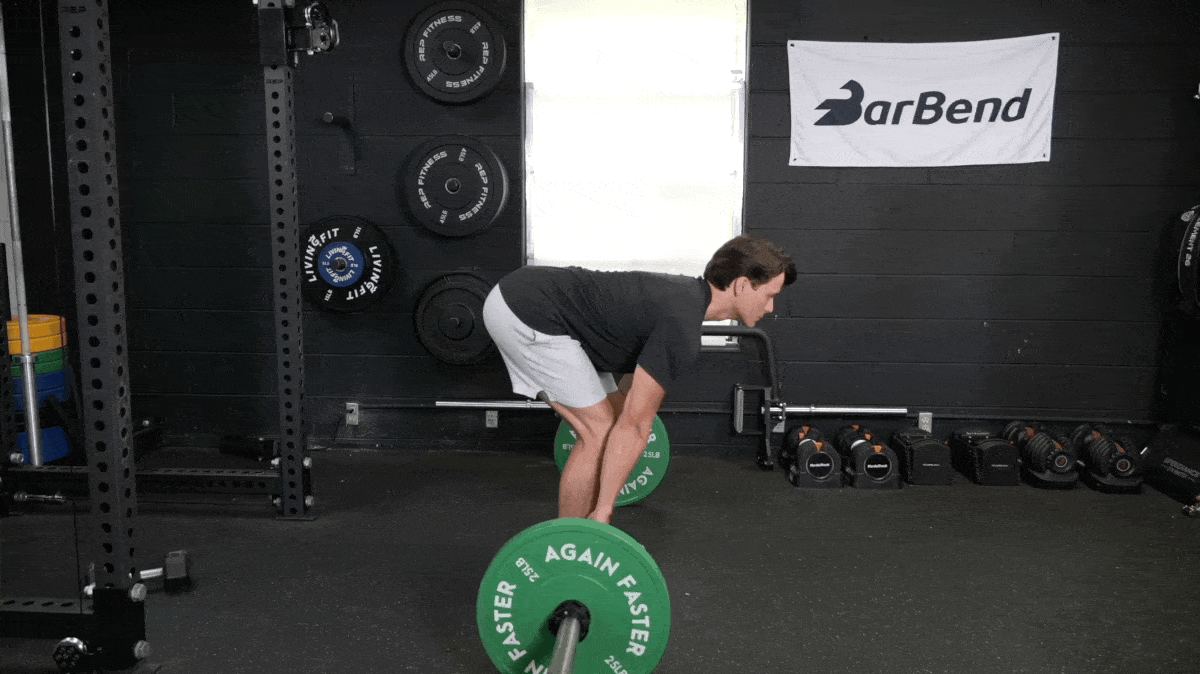
| Equipment Needed | Barbell, weight plates, lifting straps (optional), lifting belt (optional) |
|---|---|
| Muscles Worked | Hamstrings, glutes, lower back, traps |
| Sets & Reps | 3 x 8-10 |
This deadlift variation is nearly identical to the standard deadlift, except that you lower the barbell to mid-shin level by driving your hips back while keeping your core engaged with tension on your hamstrings and glutes. The Romanian deadlift is regarded as one of the best physique development variations, helping you build muscle, improve your regular deadlift, and strengthen your hips and lower back, resulting in a lesser chance of injury performing similar movements.
How To Do It
- Load a barbell up with less weight than you would for a traditional deadlift, but get in the same deadlift position — feet shoulder-width apart and hands gripping the bar just outside the knees.
- Raise your chest up and then drop your hips and pull-up on the bar until your hips are fully locked out.
- Now, push your hips back and lower the bar until it’s in the middle of your shins.
- You should feel a stretch in your hamstrings. Finish by driving your hips forward, bringing the weight back up to the starting position.
Modifications
- Make It Easier: Use lifting straps so your grip isn’t a limiting factor.
- Make It Harder: Stand on some weight plates to increase your range of motion without the plates on the bar colliding with the floor.
Coach’s Tip: Your knees should be unlocked throughout the set, but don’t bend them on purpose.
7. Nordic Hamstring Curl
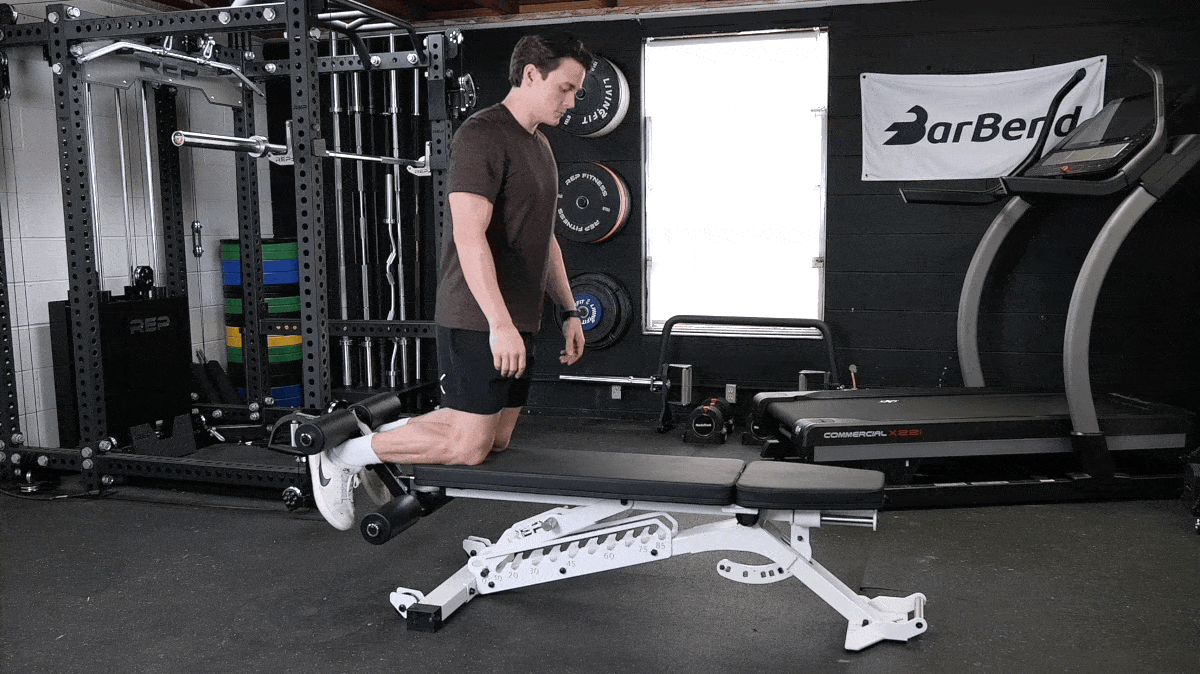
| Equipment Needed | Ankle station, knee sleeves (optional) |
|---|---|
| Muscles Worked | Hamstrings |
| Sets & Reps | 2 sets to failure |
The Nordic hamstring curl is an excellent move to build muscle and prevent injury. One study in the Journal Physiotherapy had 50 elite soccer teams in Denmark complete their usual hamstring training for 10 weeks during a mid-season break.
During that season, the group that added the Nordic curls had 15 total hamstring injuries compared to 52 in the non-Nordic curl group. (1) We’ll put it simply; this move is one of the best leg exercises for runners, athletes, and weight lifters — but there’s a catch.
“If you’re new to this exercise, it’s recommended to start with easier hamstring exercises and gradually progress to Nordic hamstring curls,” Furr advises.
How To Do It
- Anchor your feet underneath something sturdy — a loaded barbell, a bench, the legs of a cable machine — and kneel on an exercise mat.
- Extend your arms out in front of you, keep your torso straight, and bend at the knees to slowly lower yourself towards the floor.
- The lower you get, the harder the move will feel as you’re further from the anchor point.
- Catch yourself with your hands, and then push your body back up to the starting position.
Modifications
- Make It Easier: Use your hands to catch you as you lower down and actively push your body back up to the starting position.
- Make It Harder: Work up to doing at least one unassisted Nordic curl, lowering yourself to the ground and raising back up solely with your hamstrings.
Coach’s Tip: You may want to place a small mat or cushion on the floor in front of you for comfort.
8. Goblet Squat

| Equipment Needed | Dumbbell, kettlebell |
|---|---|
| Muscles Worked | Quads, glutes, core, upper back |
| Sets & Reps | 3 x 12 |
The goblet squat is a great beginner-friendly squat variation that can be done anywhere you can access a dumbbell or kettlebell. The weight is loaded in the front, which forces your back to stay upright (otherwise, you’d collapse forward). And a more upright torso helps you to get into the bottom of the squat easier while staying upright in the torso, building and strengthening the quads.
Goblets are among the best dumbbell leg exercises, especially for lifters with mobility issues or for adding volume without the compressive load of the barbell on your back.
How To Do It
- Grab a dumbbell (or kettlebell) and hold it by the head (or flip the kettlebell and hold the bell with both hands) right below your chin.
- Set your stance wide enough so your elbows can drop between your legs when you hit the bottom of your squat. This means setting your feet slightly wider than the hips for most people.
- Sit your butt back and bend at the knees to descend into a squat. Sit down as far as your mobility comfortably allows. The deeper, the better.
- Pause at the bottom of the squat for a second and then explode back up, driving through your heels.
Modifications
- Make It Easier: Place small plates under your heels to improve your ankle mobility.
- Make It Harder: Hold the weight very close to your body to increase the demand on your flexibility.
Coach’s Tip: This dumbbell leg exercise provides a counterweight in front of your body; use it to maintain an upright torso.
9. Reverse Lunge

| Equipment Needed | Barbell, weight plates, squat rack |
|---|---|
| Muscles Worked | Quads, glutes, abdominals, obliques |
| Sets & Reps | 2 x 8 |
Like any lunge, the reverse lunge is a unilateral exercise, which means it works one side of the body at a time. This alone is useful as it allows the target muscles (glute, hamstrings, and quads) on either side of your body to catch up to each other if there’s an imbalance in strength or size. The reverse lunge is also more stable than the forward or walking lunge as you’re not being thrown off balance by forward momentum.
How To Do It
- Stand with your feet together, and keep your hands at your sides or on your hips.
- Take a step back with one leg until it’s behind you and your knee is an inch or so above the floor.
- Your front leg should bend at a 90-degree angle as well. Keep your chest up and facing forward.
- Now, drive through the balls of your front foot and stand back up with control.
Modifications
- Make It Easier: Hold weights in your hands rather than balancing a barbell on your back.
- Make It Harder: Place your front leg onto a weight plate to increase the range of motion.
Coach’s Tip: You can step backward and slightly out to the side to improve your balance.
10. Barbell Hip Thrust
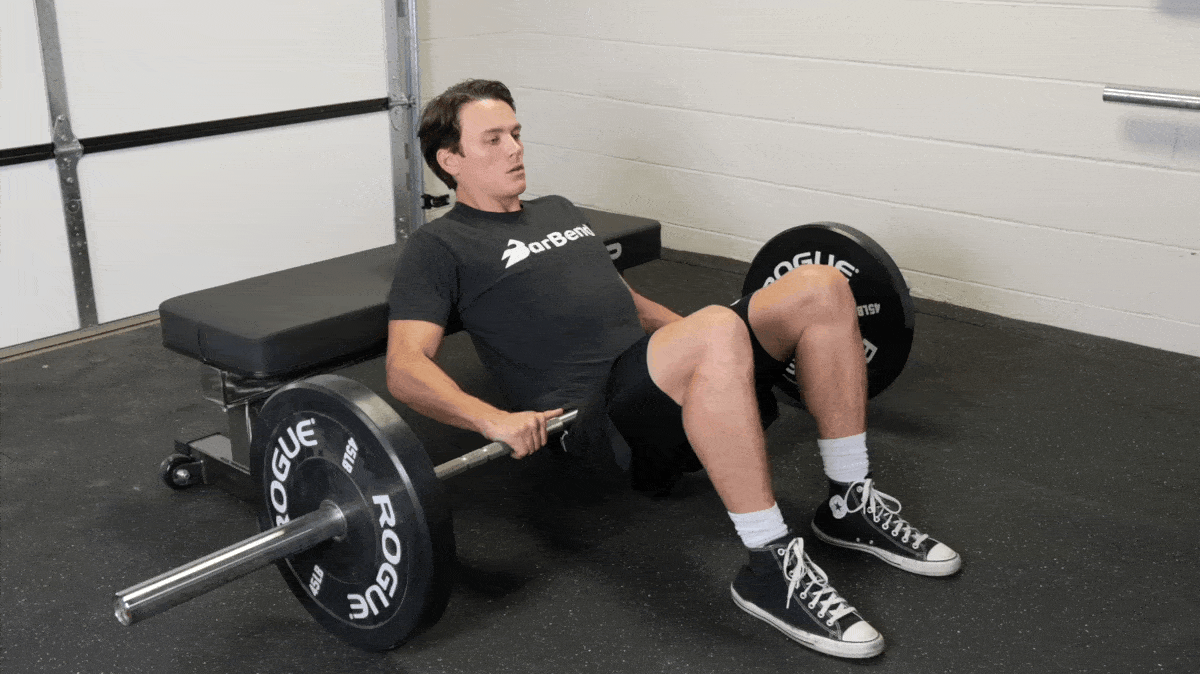
| Equipment Needed | Weight bench, barbell, weight plates, bar pad |
|---|---|
| Muscles Worked | Glutes, hamstrings |
| Sets & Reps | 4 x 8 |
There are a few major benefits to the barbell hip thrust. For one, you can directly target your glutes, which are usually an auxiliary player in moves like the lunge, squat, and deadlift. The glutes also facilitate hip extension, and the hip thrust lets you load that movement pattern without placing tension onto your lower back.
How To Do It
- Load a barbell with rubber bumper plates (if possible), as you want the bar higher up off of the ground.
- Now, roll the barbell towards you, so it’s sitting on your hips.
- Place your upper back on a bench and bend your knees with your feet flat on the floor.
- Squeeze your glutes and drive your hips up, holding onto the barbell with both hands to prevent it from falling until your body is in a straight line from knee to chin.
- Hold this position for a beat and then lower the weight back down.
Modifications
- Make It Easier: Use padding like a bar pad or rolled-up yoga mat to make this movement much more comfortable on your pelvis.
- Make It Harder: Try a B-stance hip thrust, extending one leg further than the other and using it for stability like a kickstand.
Coach’s Tip: At the top of the hip thrust, your thigh and shin should form a perfect 90-degree angle.
11. Leg Extension
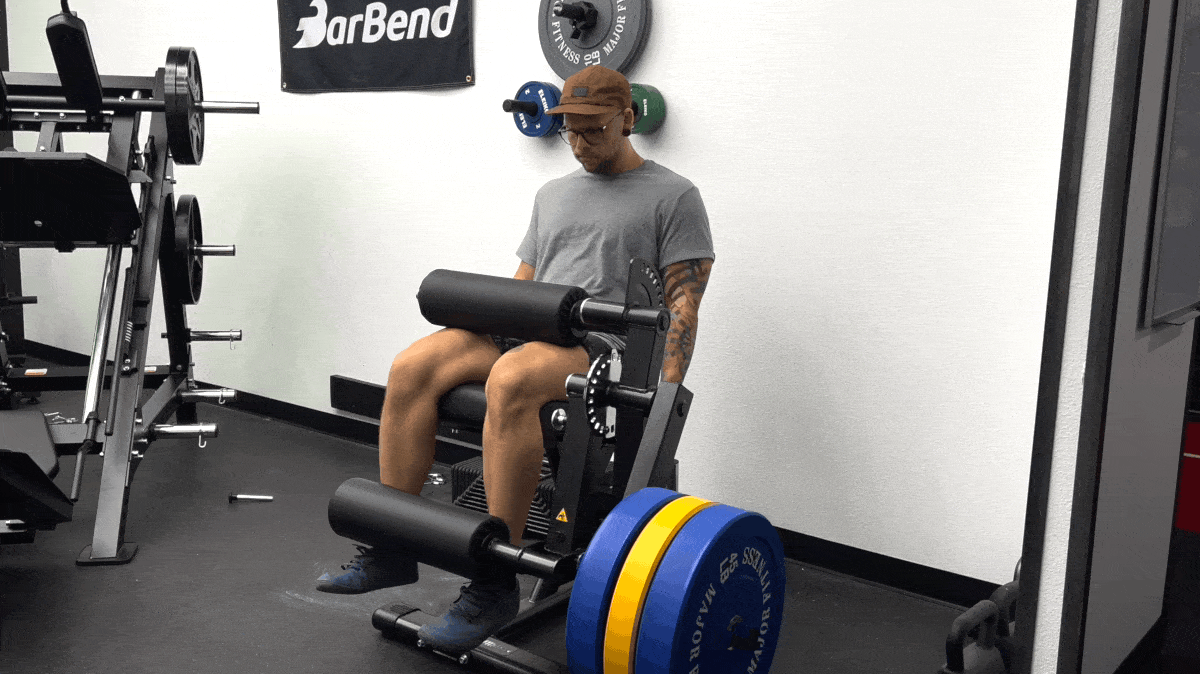
| Equipment Needed | Leg extension machine |
|---|---|
| Muscles Worked | Quads |
| Sets & Reps | 3 x 15 |
The leg extension is a stellar exercise to hone in on your quads when performed with control and proper form. Other benefits: It’s easy to learn and execute (there’s practically no learning curve), it doesn’t load your spine in any way, it requires comparatively little weight to be effective, and it targets the rectus femoris muscle in its shortened position — a quadriceps muscle that crosses the hip joint and plays an important role in helping stabilize the pelvis in other strength training exercises.
How To Do It
- Adjust the back pad on the machine and line your knee up with the axis of rotation (signified by a dot or marker on the machine) and adjust the ankle pad, so it rests on your shoelaces to touch just above the shoe.
- Extend the knee to move the ankle pad, then accelerate into the rep until you reach the end range of the knee extension.
- Ensure your ankle is in dorsiflexion — toes pointed straight ahead or slightly up. Lower weight back down with control.
Modifications
- Make It Easier: Have a partner or spotter assist you in lifting the pad up with your quads.
- Make It Harder: Slow down your tempo and take 3 full seconds to lower the weight each time.
Coach’s Tip: Grab onto the handles of the seat and actively try to pull your butt into the pad the entire time.
12. Side Leg Raise
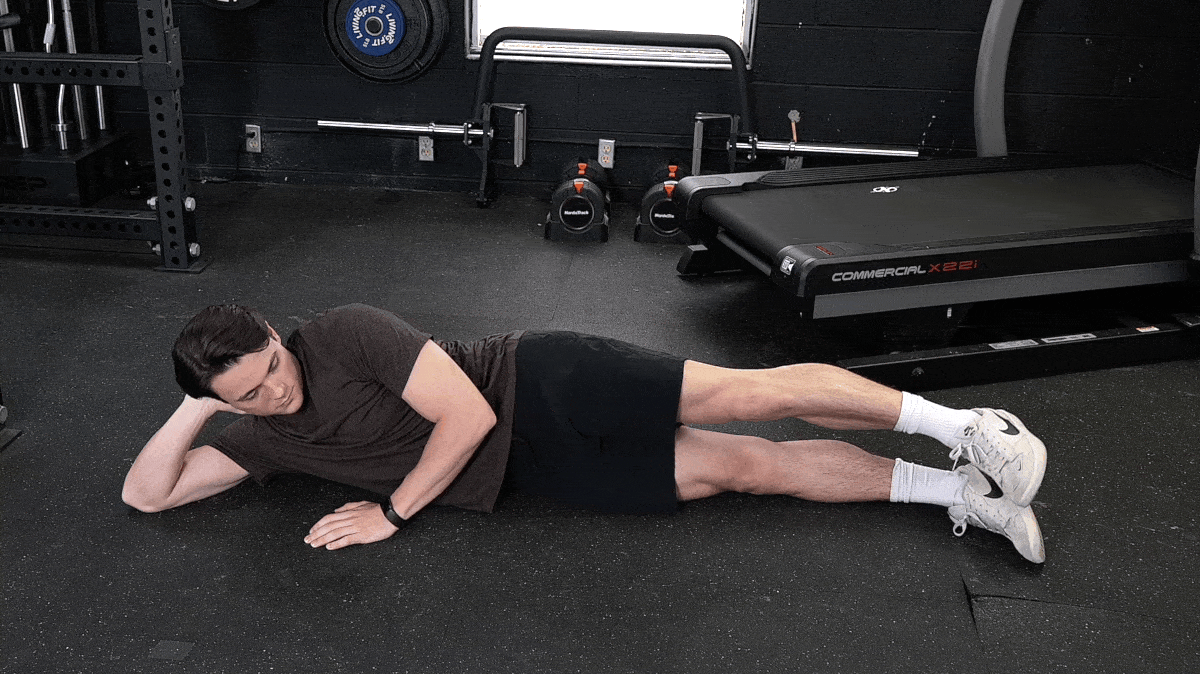
| Equipment Needed | Exercise mat (optional) |
|---|---|
| Muscles Worked | Glute medius |
| Sets & Reps | 2 x 20 |
Most single-leg exercises that involve working in a different plane of motion ask a lot of your balance. You can get around that demand and work your glutes at the same time by performing side leg raises on the floor instead.
How To Do It
- Lie on your non-working side and support your torso by placing that elbow on the floor.
- Straighten your top leg such that your hip and knee are both extended.
- Without bending your knee or tilting your torso, lift your foot up toward the ceiling as high as you comfortably can.
Modifications
- Make It Easier: Bend your working knee to lighten the load on your hip.
- Make It Harder: Hold a small weight plate on the outside of your hip to add a bit of external load, or wear ankle weights.
Coach’s Tip: If you’re having trouble stabilizing yourself, you can bend your non-working knee while it rests on the floor.
13. Lying Leg Curl
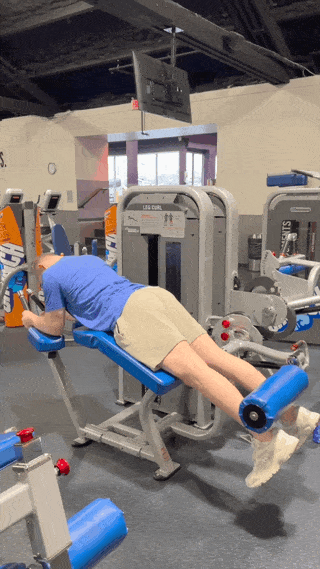
| Equipment Needed | Lying leg curl machine |
|---|---|
| Muscles Worked | Hamstrings |
| Sets & Reps | 3 x 12 |
The lying leg curl offers a unique benefit. We like it because it allows you to fully isolate your hamstrings, which can be great for additional muscle gains. Keeping your abs and lats engaged throughout the range of motion helps stabilize your upper body, making it easier to create more force in the lower body and keep the focus on the hamstrings.
How To Do It
- Adjust the leg pad on the machine and line your knee up with the axis of rotation (signified by a dot or marker on the machine) and adjust the ankle pad to touch just behind the ankle.
- Engage the hamstrings and bring your heels to your butt.
- Ensure your ankle is in dorsiflexion — toes pointed straight ahead or slightly up.
- Control the weight as you return to the starting position.
Modifications
- Make It Easier: Work with lighter weights or adjust the shin pad to be closer to your knees rather than your ankles.
- Make It Harder: Slow down your tempo and take 3 seconds to lower the weight during each rep.
Coach’s Tip: Keep your pelvis firmly locked into the pad the entire time.
14. Standing Calf Raise
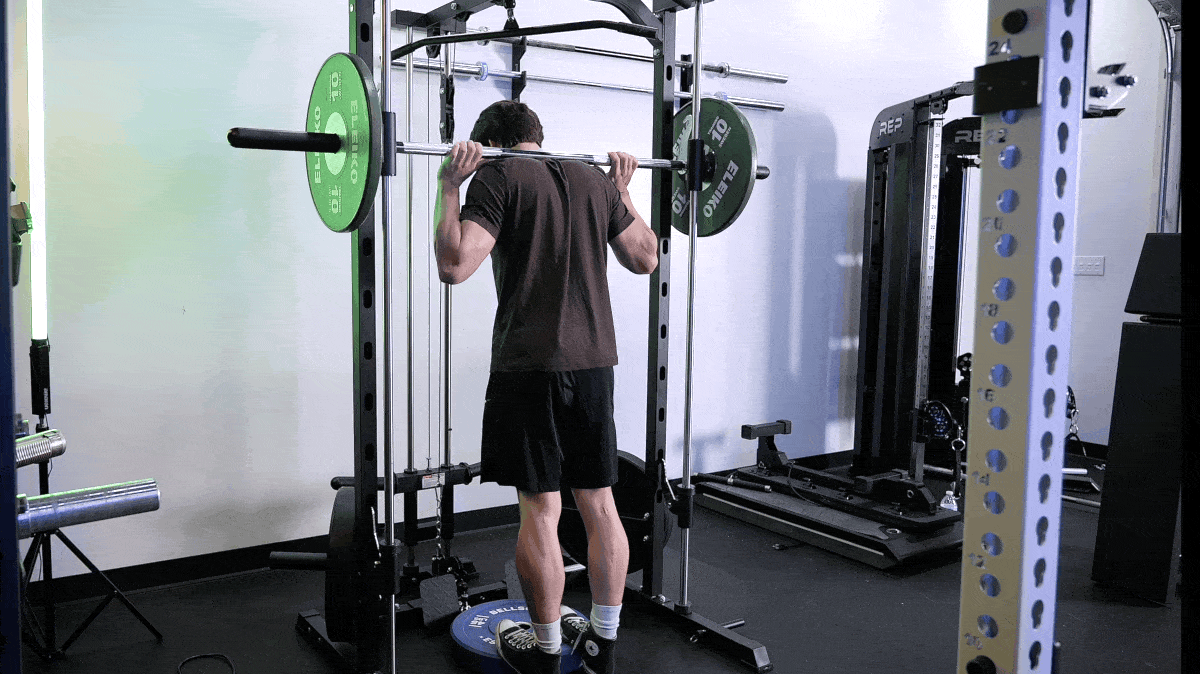
| Equipment Needed | Smith machine, barbell + squat rack, dumbbells or kettlebells, low riser or weight plates |
|---|---|
| Muscles Worked | Calves |
| Sets & Reps | 3 x 12 |
The standing calf raise exercise is the bread and butter of calf training. This move trains your calves in a way you can’t get from hiking, sprinting, or playing sports. The controlled stretch and external load will help you grow your calves and strengthen the surrounding soft tissues like your Achilles tendon.
How To Do It
- Stand up straight with your legs extended (slight bend at the knee) with the balls of your feet on the step and the load atop the shoulders. Stand on a bumper plate so you can get a deeper stretch.
- Unrack the weight and slowly lower your heels as far as possible to the floor.
- Then lift your heels as far as possible, squeezing your calves at the top of the movement. Slowly lower down and repeat.
[Read More: The Best Calf Exercises for Lower Body Support and Power]
Modifications
- Make It Easier: Perform calf raises with your feet on the floor to reduce the range of motion.
- Make It Harder: Do calf raises one leg at a time.
Coach’s Tip: Pause at the bottom of each rep to remove momentum from the equation.
15.Side Lunge
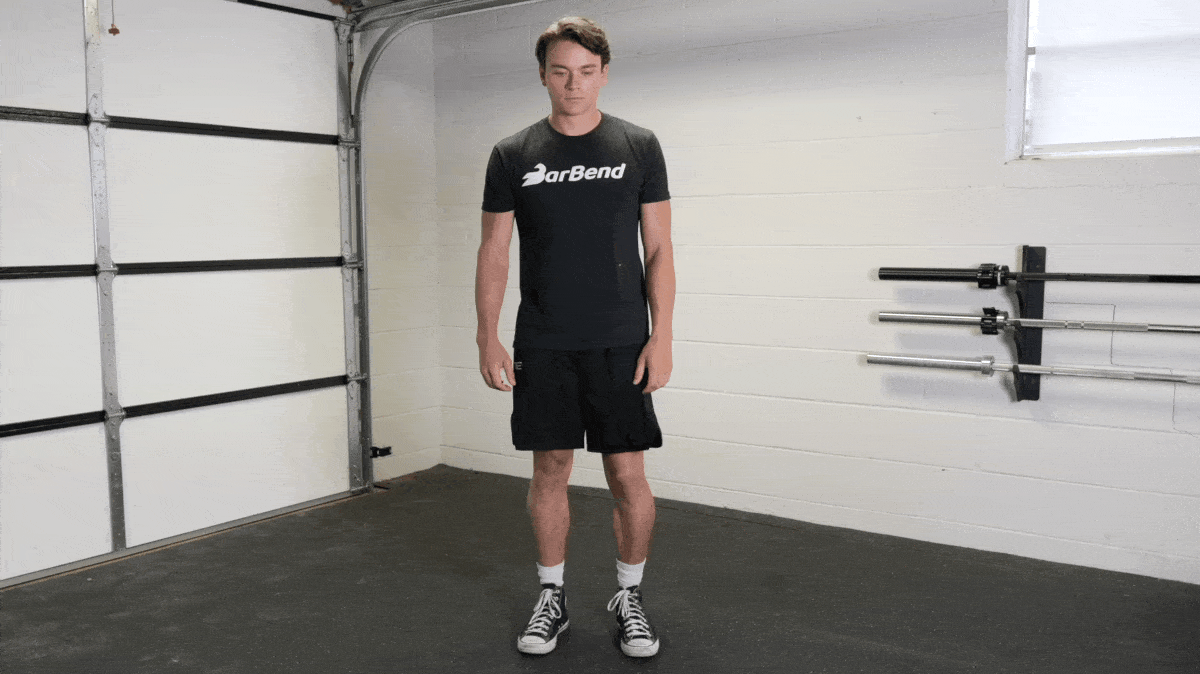
| Equipment Needed | Dumbbells (optional), kettlebells (optional), medicine ball (optional) |
|---|---|
| Muscles Worked | Quads, glutes, adductors, core |
| Sets & Reps | 2 x 12 |
Side lunges, also called lateral lunges, are one of the best unilateral leg exercises you can perform, for one specific reason — they teach you to move and stabilize your body in a different plane of motion.
How To Do It
- Stand upright in a regular stance with your feet under your hips.
- Reach one leg out to the side and plant it about two feet away.
- As you plant your foot on the floor, step into that side, bending your knee and flexing at the hip.
- Push off the floor with that leg to return to the starting position.
Modifications
- Make It Easier: Hold onto a pillar or weight bench as you step sideways to help your balance.
- Make It Harder: Use external resistance like a barbell or dumbbells.
Coach’s Tip: Clasp your hands together in front of you if desired, or hold them extended in front like a zombie to help your balance.
16. Good Morning
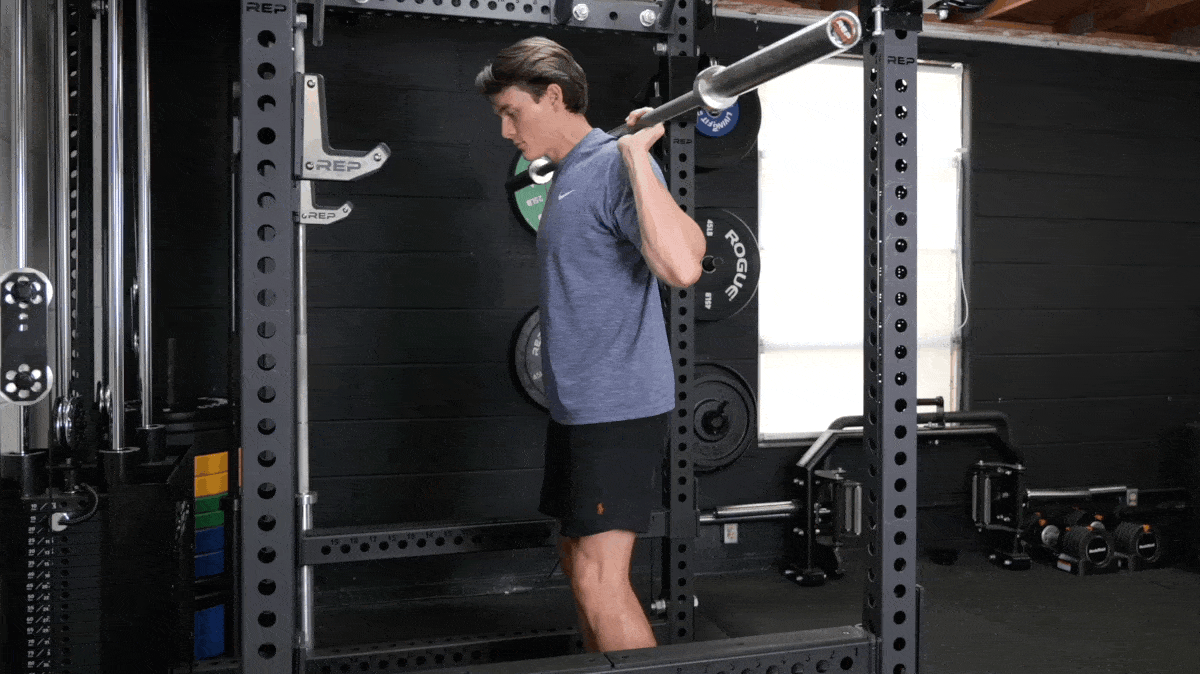
| Equipment Needed | Barbell, weight plates (optional) |
|---|---|
| Muscles Worked | Lower back, glutes, hamstrings |
| Sets & Reps | 2 x 8 |
Good mornings train more than good manners. This bowing exercise mimics the posture of a Romanian deadlift, but by holding the weight on your back, you can lengthen the exercise’s moment arm — the distance between the load (the bar) and the lever (your hips). This makes light weights feel heavier, letting you train your backside without having to use heavy weights.
How To Do It
- Step under a loaded barbell that’s set in a power rack. Set up the same way you would for a back squat, and walk backward a few steps.
- With a slight bend in your knees, hinge at the hips while keeping your chest up and shoulders down.
- Hinge until your torso is almost parallel to the floor.
- Reverse the lift by contracting your glutes and hamstrings until you are standing back up.
Modifications
- Make It Easier: Clutch a medicine ball or dumbbell to your chest rather than holding a bar on your back.
- Make It Harder: Slow down your tempo and pause in the bowed position.
Coach’s Tip: The good morning is deceptively challenging. Start with just an empty barbell as you learn it.
17. Glute Bridge
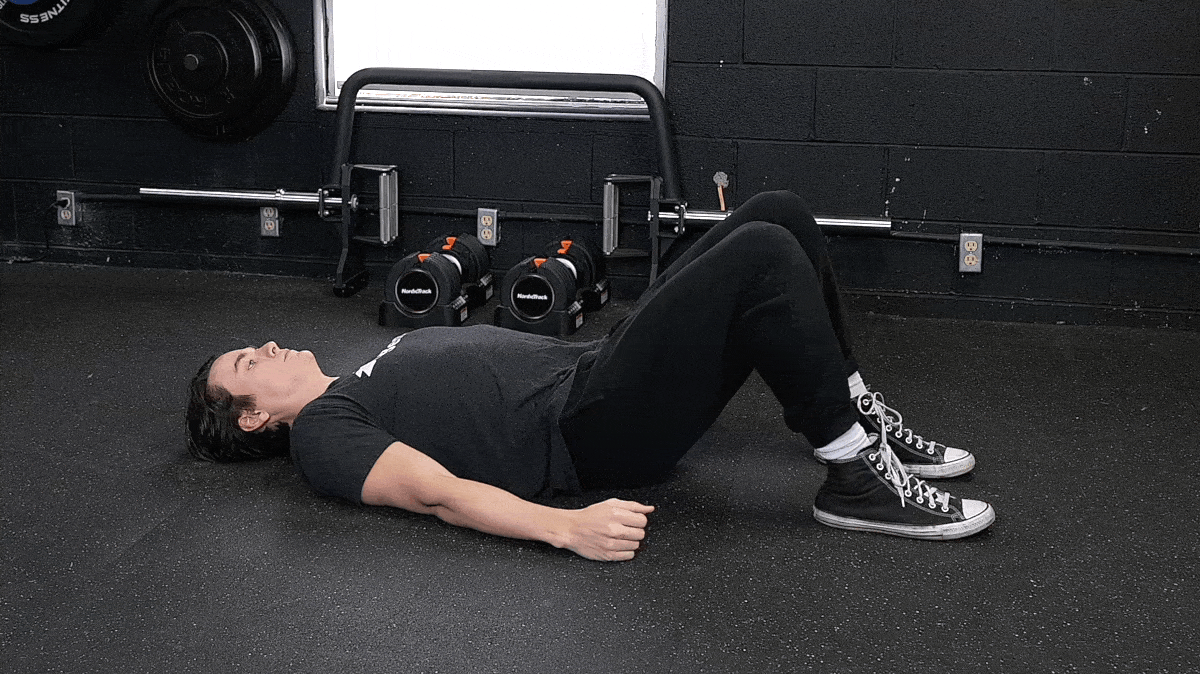
| Equipment Needed | Exercise mat (optional) |
|---|---|
| Muscles Worked | Glutes, hamstrings |
| Sets & Reps | 3 x 15 |
We love the glute bridge because it teaches you how to execute the all-important movement pattern of hip extension. This motion engages your glutes, hamstrings, and lower back, and is integral during many leg day exercises. To learn it safely without using heavy weights, start simple with the bridge.
How To Do It
- Lie on the floor on your back and bend your knees so your feet plant flat on the floor. Relax your arms by your sides.
- Lift your hips off the floor by contracting your glutes.
- Push your hips up toward the ceiling until your body forms a straight line from kneecap to shoulder.
Modifications
- Make It Easier: Place your hands out to your sides with your palms on the floor to help you balance.
- Make It Harder: The bridge is also one of the best single-leg exercises you can do for your glutes if you perform it with one leg held in the air.
Coach’s Tip: Focus on pushing through your heels when performing the glute bridge.
18. Kettlebell Swing
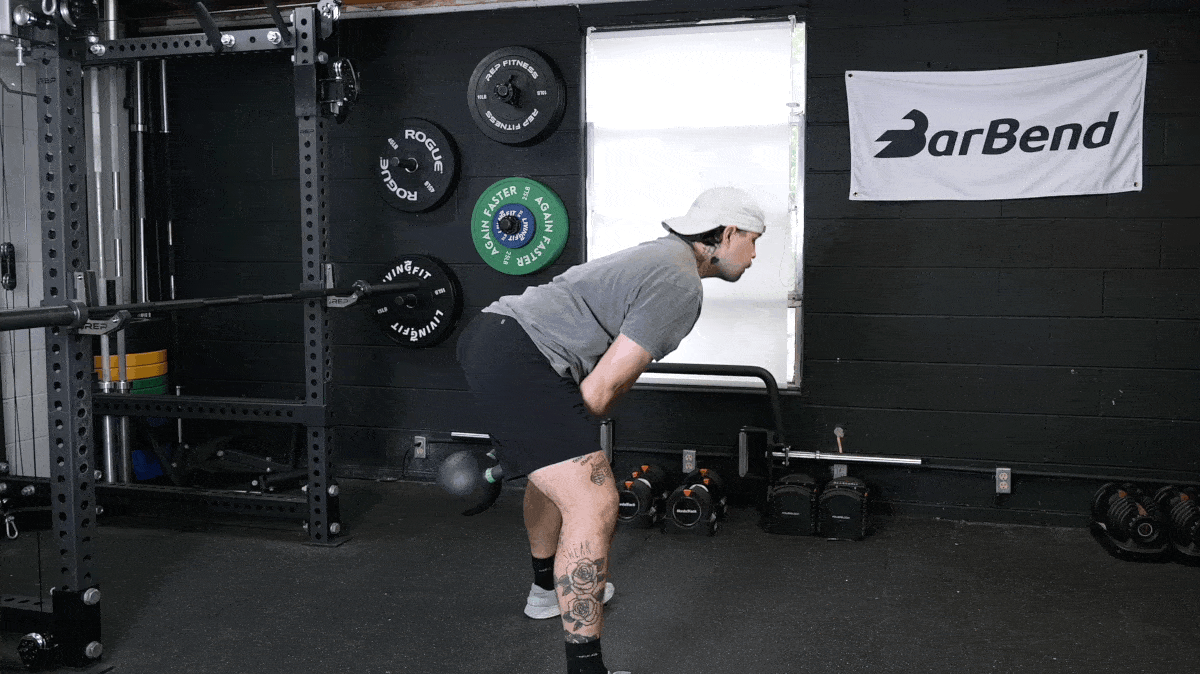
| Equipment Needed | Kettlebell, chalk (optional) |
|---|---|
| Muscles Worked | Glutes, hamstrings, lower back, core |
| Sets & Reps | 3 x 20 |
Kettlebell swings reinforce proper hip hinge mechanics and can help you break a sweat in no time. Other benefits include plenty of glute, hamstring, and lower back activation. It’s also worth mentioning that kettlebell swings are one of the most accessible leg movements out there; you can find at least a handful of ‘bells in nearly every gym.
How To Do It
- Take a shoulder-width stance, or slightly wider, with a kettlebell on the floor between your feet.
- Hinge down and grab the handle of the bell. From here, sweep it back between your legs to establish momentum.
- Extend your hips to thrust the bell forward and up.
- As it descends again, fall back into a hinge position.
- Once you get into a rhythm, you should be able to swing the weight by snapping your hips into extension.
Modifications
- Make It Easier: Work with a light kettlebell until you understand the hinge technique.
- Make It Harder: Allow the kettlebell to fly upward above your head rather than stopping it at shoulder height.
Coach’s Tip: Keep your arms tucked to your sides at the top of each rep; the bell should swing up to about the height of your navel.
19. Cyclist Squat
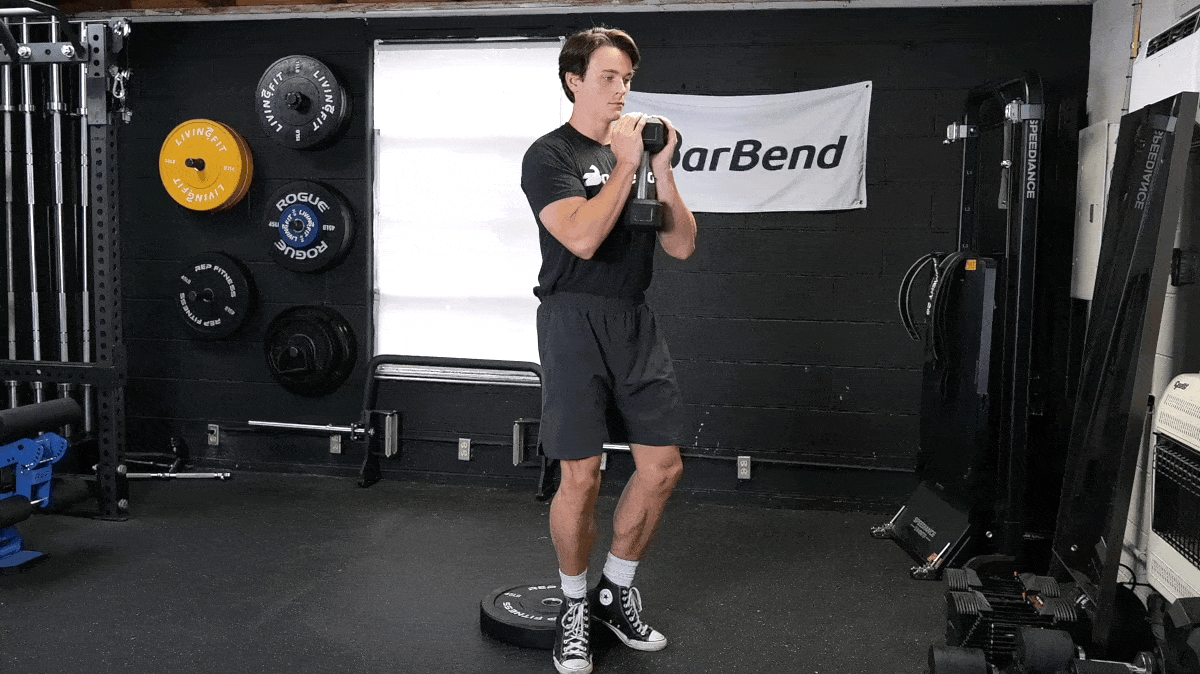
| Equipment Needed | Bumper plate or riser, dumbbell (optional), kettlebell (optional), weightlifting shoes |
|---|---|
| Muscles Worked | Quads |
| Sets & Reps | 2 x 20 |
If you’ve ever squatted while wearing weightlifting shoes, you know how much of a game-changer it can be to elevate your heels. The cyclist squat takes that idea to the next level; by placing a high wedge under your heels, you can hammer your quads and take other muscles out of the equation almost entirely. The cyclist squat is one of the best quad-focused squat variations out there and can be effective even with very light weights.
[Read More: The Best Quad Exercises for Muscle Growth and Strength]
How To Do It
- You’ll need to prop your heels up onto an elevated surface for this one, such as a bumper plate.
- Place your feet close together and stand fully upright.
- From here, slowly sink down into a narrow-stance squat by allowing your knees to travel far in front of your toes.
- You should be able to easily compress your hamstrings onto your calves. Pause for a moment at the bottom and then flex your quads to return to the starting position.
Modifications
- Make It Easier: Work with just your body weight to start.
- Make It Harder: Try a pause at the bottom of each rep.
Coach’s Tip: There’s such a thing as too much heel elevation; if you feel yourself falling forward on every rep, you’re likely using too much.
20. Belt Squat
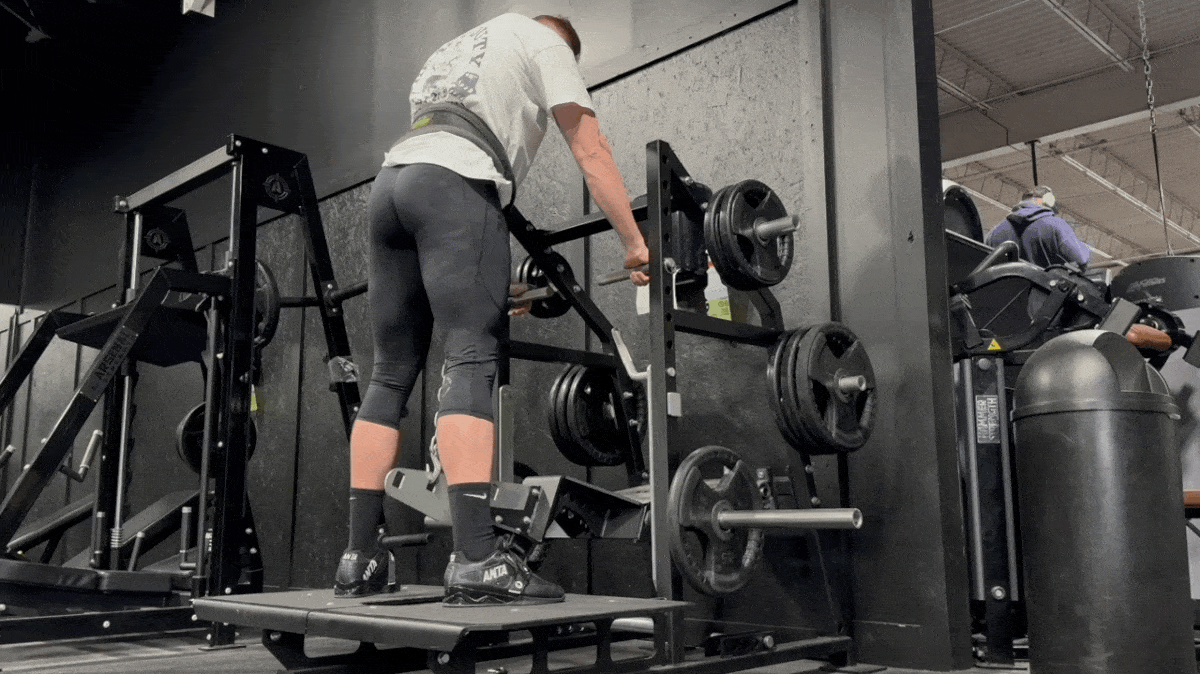
| Equipment Needed | Belt squat machine |
|---|---|
| Muscles Worked | Quads, glutes |
| Sets & Reps | 3 x 12 |
If you have access to a belt squat machine in your gym, you’d be foolish not to make use of it. While somewhat rare, the belt squat is an invaluable tool for building your legs. The defining feature of the hip belt squat is that instead of the weight pushing down on your spine, it pulls down on your hips. This makes the belt squat an amazing workaround if you’re nursing an injury or want to squat without fatiguing your posterior chain at all.
How To Do It
- If you have a belt squat station in your gym, this exercise is pretty grab-and-go. If not, you can wrangle it with a dip belt, some weight plates, and by standing on two high boxes.
- Assume your normal squat stance or slightly wider and sit into a deep squat by allowing the resistance to pull your pelvis directly downward.
Modifications
- Make It Easier: Adjust the chain to limit the range of motion before the anchor makes contact with the floor.
- Make It Harder: Pause at the bottom of each repetition.
Coach’s Tip: Avoid gripping the handrail too tightly and using it to pull yourself up out of the squat. Let your legs do the work.
Sample Leg Workouts
The best leg exercises in the world won’t do you a lick of good if you can’t organize them into a proper workout. Designing the best leg workout takes time, effort, and a comprehensive understanding of exercise science. Or, you can pick one of these tailor-made workout routines and get right down to business:
Leg Day Warm-Up
The amount of “work” you do during your warm-up should be enough to prepare you to train, but not tire you out at all. If you’re healthy, flexible by default, or not performing many intricate movements on leg day, you needn’t spend 20 or 30 minutes getting ready to lift.
[Read More: The Best Leg Stretches to Bolster Your Lower Body Training]
Run through this protocol and modify it as needed to match your level of fitness. If you’re feeling cold or sluggish, add a few more minutes of cardio. If your squats or deadlifts feel out of whack or inconsistent, add a couple extra ramping sets to dial in your technique:
- 5-10 minutes of light cardio (stair-stepper, incline treadmill, elliptical, or sled push)
- 1-3 dynamic mobility drills (high knees, leg swings, kickbacks, or Cossack squats)
- 1-4 ramp-up sets of your first compound exercise, beginning with the empty barbell and slowly adding weight. Perform only a few (1-5) reps per set.
Leg Workout for Mass
A good muscle-building leg workout should meet certain criteria. You need exercises that hit both the fronts and backs of your legs, for one. You also need to utilize a variety of rep ranges and equipment for a comprehensive stimulus. The secret sauce, though, is work ethic — be ready to go hard on this one.
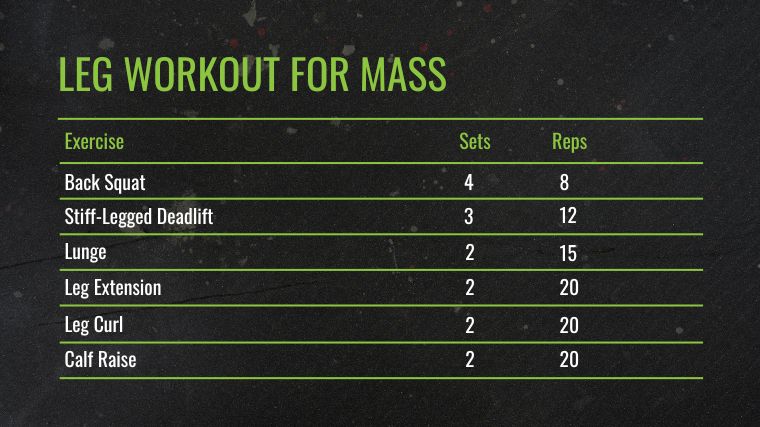
- Back Squat: 4 x 8
- Stiff-Legged Deadlift: 3 x 12
- Lunge: 2 x 15
- Leg Extension: 2 x 20
- Leg Curl: 2 x 20
- Calf Raise: 2 x 20
Leg Workout at Home
Here’s a short workout you can do at home using mostly bodyweight leg exercises. This workout will strengthen and tone your legs while also helping you learn correct exercise technique in a safe environment.
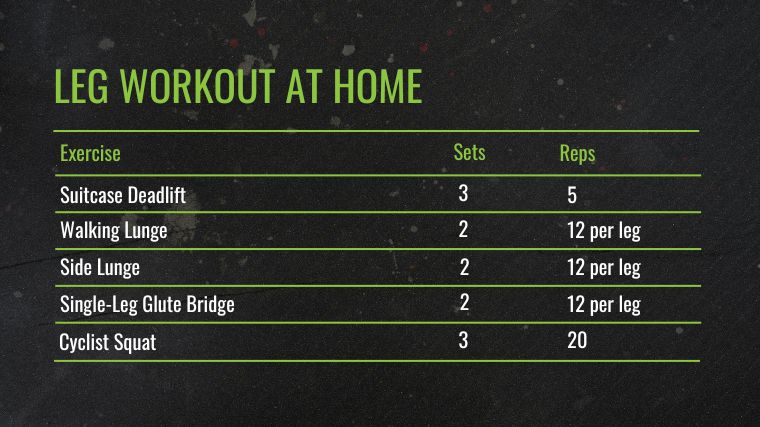
- Suitcase Deadlift: 3 x 5
- Walking Lunge: 2 x 12 per leg
- Side Lunge: 2 x 12 per leg
- Single-Leg Glute Bridge: 2 x 12 per leg
- Cyclist Squat: 3 x 20
Leg Workout for Strength
Building strength in your legs is all about mastering your body’s fundamental movement patterns. Specifically, you need to get really good at squatting and hinging. Try this strength-building leg workout to build some serious lower body stability and set new personal records in the process:
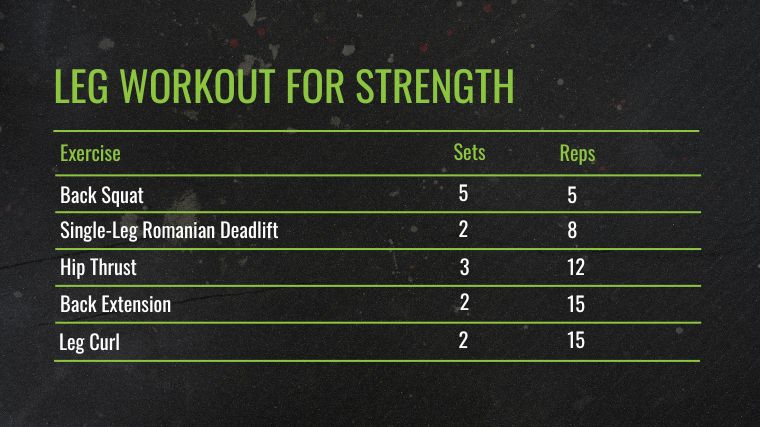
- Back Squat: 5 x 5
- Single-Leg Romanian Deadlift: 2 x 8
- Hip Thrust: 3 x 12
- Back Extension: 2 x 15
- Leg Curl: 2 x 15
Leg Training Tips
When training your legs to grow or get stronger, there are a handful of rules that can help you improve your performance while managing injury risk.
Breathe and Brace
When loading heavy weight on your back, breathing and proper bracing become vital to your ability to safely and effectively maximize performance. The more you sharpen this skill, the more rhythmic and natural it becomes.
[Read More: Science-Backed Benefits of Walking for Strength Athletes]
For free weight exercises and machines, it is a good rule of thumb to breathe in before you start the motion or go through the eccentric portion; breathe out as you push through the concentric part of the exercise. To remain braced, maintain engagement of your core throughout your reps.
Your Technique Matters
You won’t be able to reap the benefits of leg training without having proper technique. Poor form leads to other muscles compensating for the ones that should be working. Someone with weak hips, for example, may hinge forward during a squat, placing undue stress on their lower back.
[Read More: The Best Bodybuilding Leg Workouts for Your Experience Levels]
If you find yourself performing any of the movements listed above with poor form, the solution is most likely to lighten the load and build good habits before returning to a heavier weight.
Choose the Best Exercises for You
Finding exercises that work well for you — your skill level, structure, and mechanics, alongside your goal — is important for maximizing your training experience. As you can see, there are many different ways to train your legs.
[Read More: What Are Workout Splits and Which Is the Best One?]
If, for example, you have been injured performing the back squat in the past, there are other ways to mimic this same stress on the body, such as the hack squat or leg press. There are no absolute must-do movements when it comes to leg training.
Benefits of Training Your Legs
There are plenty of reasons to train your legs: Leg training improves one’s ability to explode; leg exercises burn more calories; leg muscle is aesthetic, and all of the movements on this list will help you move better overall. Here, we’ll dig deeper into the reasons why you shouldn’t skip leg days.
You’ll Become More Powerful
Almost every full-body movement starts from the ground up — sprinting, jumping, even throwing a punch. One study published in the Journal of Sports Medicine had 20 athletes perform four sets of 10-rep max back squats twice a week for six weeks. Afterward, the subjects improved their leg press strength, countermovement squat jump performance, and sprint. (3)
You’ll Burn More Calories
Leg training burns a lot of calories. One 2017 study showed that a workout consisting of common leg workout movements burned up to 20 calories per minute. (4)
You’ll Be More Symmetrical
You don’t need a fancy study to tell you that if you don’t train your legs, they won’t grow — and then, what, you’ll be the guy with biceps the size of his thighs? Even if you never plan to compete in a bodybuilding show, there’s an aesthetic benefit to having muscular legs to go along with your chest, back, shoulders…you get the idea.
Leg Workouts Make You More Mobile
Aside from moving more quickly and powerfully, training your legs can improve your everyday mobility. The squats, lunges, and deadlifts you perform in the gym will, over time, make you stronger and more proficient at the movements you engage in daily.
[Read More: How to Do the 90/90 Stretch to Squat Heavier and Move Better]
An analysis of studies on PubMed that explored the effects of strength training in the elderly concluded that strength training in the senior population could reduce sarcopenia (or muscle loss) and retain motor function. (5)
What Muscles Make Up the Legs
Knowing about the muscles in your legs and their functions may help you understand how to better train your lower body. Here are the major muscles involved in most standard leg exercises.
Credit: Jacob Lund / Shutterstock
[Related: The Anatomy of Your Leg Muscles, Explained (and How To Train Them)]
Glutes
The gluteus maximus, medius, and minimus help the hip extend, externally and internally rotate, and abduct (moving the thigh away from the body). Your glutes are engaged during exercises like squats, deadlifts, or lunges.
Quads
Your quads have four distinct heads and mainly serve to straighten your knee when you squat, jump, lunge, run, and so on.
Hamstrings
Think of your hamstrings (known anatomically as the biceps femoris) as the opposite of the quads. Your hamstrings bend your knee and straighten your hips, and are used during all hinge movements.
Adductors
The muscles of the inner thigh — known as the adductors — adduct the thigh (moving thigh toward the body) and act as important stabilizers of the pelvis during any side-to-side movements.
Calves
Your calves are located between your foot and knee. These muscles help push your toes downward and are integral during athletic movements like running, jumping, and even Olympic lifting.
Frequently Asked Questions
What is the best leg exercise?
There’s no single “best” leg exercise. However, you can find the most appropriate leg exercise for you. In general, you can cover your leg workout bases by performing at least one squat variation and one hinge variation per workout.
Examples of this include goblet squats or barbell squats as well as a lunge. For hinge movements, think of Romanian deadlifts, hip thrusts, or good mornings.
How often should I train my legs?
Your leg muscles are large and powerful, which means they can move serious weight and produce a lot of power. However, that also means they take longer to recover than smaller muscles. In general, to prioritize your leg training, aim for two weekly workouts at most.
How do I work out my legs at home?
Gym equipment can be tremendously helpful when it comes to building leg muscle or strength, but going to the gym isn’t a requirement — especially for beginners. You can perform leg workouts at home by using household items as weights such as backpacks or suitcases. Also, try working on challenging bodyweight moves like single-leg squats and hinge exercises. These variations are challenging without requiring lots of external weight.
References
- Schache A. (2012). Eccentric hamstring muscle training can prevent hamstring injuries in soccer players. Journal of physiotherapy, 58(1), 58.
- Wirtz, N., Zinner, C., Doermann, U., Kleinoeder, H., & Mester, J. (2016). Effects of Loaded Squat Exercise with and without Application of Superimposed EMS on Physical Performance. Journal of sports science & medicine, 15(1), 26–33.
- Reis, V. M., Garrido, N. D., Vianna, J., Sousa, A. C., Alves, J. V., & Marques, M. C. (2017). Energy cost of isolated resistance exercises across low- to high-intensities. PloS one, 12(7), e0181311.
- Mayer, F., Scharhag-Rosenberger, F., Carlsohn, A., Cassel, M., Müller, S., & Scharhag, J. (2011). The intensity and effects of strength training in the elderly. Deutsches Arzteblatt international, 108(21), 359–364.
- Alshami, A. M., & Alhassany, H. A. (2020). Girth, strength, and flexibility of the calf muscle in patients with knee osteoarthritis: A case-control study. Journal of Taibah University Medical Sciences, 15(3), 197–202.
Featured Image: UfaBizPhoto / Shutterstock
